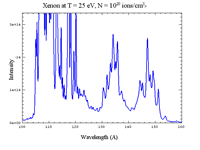
The ATBASE suite of atomic physics codes is used to generate high-quality atomic data for simulating the spectral properties and ionization dynamics of plasmas over a wide range of conditions. It utilizes a suite of atomic structure and modeling codes, including Hartree-Fock, Dirac-Fock, configuration interaction, and distorted wave codes.
ATBASE atomic data has been used extensively in the analysis of spectra from laboratory and astrophysical plasmas. Prism Atomic Data is used in other Prism codes (SPECT3D, PrismSPECT, HELIOS-CR, and PrOpacEOS) to simulate the ionization dynamics and detailed spectral properties of LTE and non-LTE plasmas.
Applications
The ATBASE database has been used extensively in a variety of plasma physics studies, including:- Simulation of spectral properties and ionization dynamics of laser-produced plasmas
- Analysis of spectra of radiatively-heated materials in laser and high-current Z-pinch experiments
- The ionization dynamics and spectral properties of plasmas heated by energetic ions and non-Maxwellian electron distributions
- The formation of inner-shell Kα emission spectra from materials heated by intense ion beams
- The analysis of high-resolution Chandra spectra from high-luminosity stars
- The ionization structure of stellar winds and their radiative properties at UV, EUV, and X-ray wavelengths
Overview of Models
ATBASE generates a comprehensive set of atomic data for all ions of any atomic element. The types of data generated include:
- Atomic energy levels and oscillator strengths
- Photoionization cross-sections
- Electron collisional excitation and ionization cross-sections
- Autoionization rates
- Dielectronic recombination (DR) rate coefficients
Computed using Hartree-Fock and configuration interaction models. When available, experimentally-based energy levels and radiative data are utilized.
Cross-sections from Hartree-Fock calculations are utilized for both valence-shell and inner-shell transitions. Radiative recombination rate coefficients are calculated from the photoionization cross-sections.
Distorted-wave (DW) calculations are performed to generate cross-sections and rate coefficients.
Configuration interaction (CI) calculations are performed to generate autoionization rates.
For dielectronic recombination related to K-shell spectra (Li-like ions and higher), electron capture rates are computed using autoionization rates and the detailed balance relationship. For lower ionization stages, total dielectronic recombination rate coefficients are based on semi-empirical models.